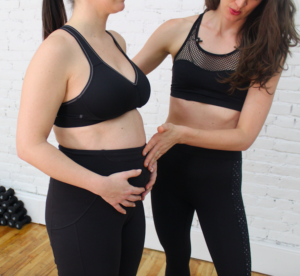The Myth: It’s safe to return to your pre pregnancy workout as soon as you get the “green light from your care provider.

The FPC Answer: Most care providers will give you the green light at around 6 weeks to resume exercise. But what does that mean?
Did you know that the first 12 weeks post birth are known as the “critical healing period”? (12! not 6). Many women return to their favorite workouts too soon and too hard and put themselves at risk of developing complications. Even if you feel amazing, the exercise choices you make during those initial weeks can effect your body for the rest of your life. We could probably write you a book on the topic, but you’re busy so here are some important bullet points instead:
Before returning to exercise post birth:
- It takes 4 months after you have given birth OR are done breastfeeding for your body to stop producing the hormone relaxin. As long as relaxin is present, the connective tissue between your rectus abdominis (6-pack abs) is still vulnerable. That is why we continue to offer safe “core” alternatives for all our newly postpartum moms.
- No matter how good that new mom, “yoga teacher” or “fitfluencer” looks on instagram, when she tells you it’s safe to do crunches at 3 weeks postpartum, it’s important to remember that traditional abdominal work like crunches, twists, planks, etc. are absolutely out of the question during those first 12 weeks. It’s not because you can’t do them (because we know you can) but it’s just really because we would hate for you to develop a Diastasis Recti AFTER pregnancy or end up with other complications!
- If you still have ab separation at 12 weeks, you need to continue to modify your workout and also be working with a postpartum fitness specialist (meaning: EVERY FPC instructor) that can help you heal.
- This might sound obvious but you cannot trust YouTube or even an instructor with a general pre/postnatal certification to do a Diastasis Recti (abdominal separation) assessment. They have a very limited knowledge of the topic and they may determine that you are fine when in fact, you are not. They might tell you that you have an ab separation when they don’t understand the true definition of what it means to heal it. Find a specialist: Come see us at FPC, watch our online videos or find a pelvic floor therapist for a proper diagnosis and next steps.
- Don’t go for a run just yet! Regardless of the type of birth you had, vaginal or Cesarian, you have to continue to train with your pelvic floor in mind. Damage to the pelvic floor doesn’t usually come from the actual birth. It comes from the months of weight and pressure on those muscles leading up to the big event. After birth, those muscles need time to rest and recover. If we return to high impact movements right away, you are putting your pelvic floor at risk of developing a prolapse.
This is just the tip of the iceberg when it comes to postpartum fitness. FPC is passionate about educating every woman that walks through our door on how to make a complete recovery post birth. If you are postpartum and looking to get back into fitness, check out our daily Livestreams or join our Anywhere Online Studio!